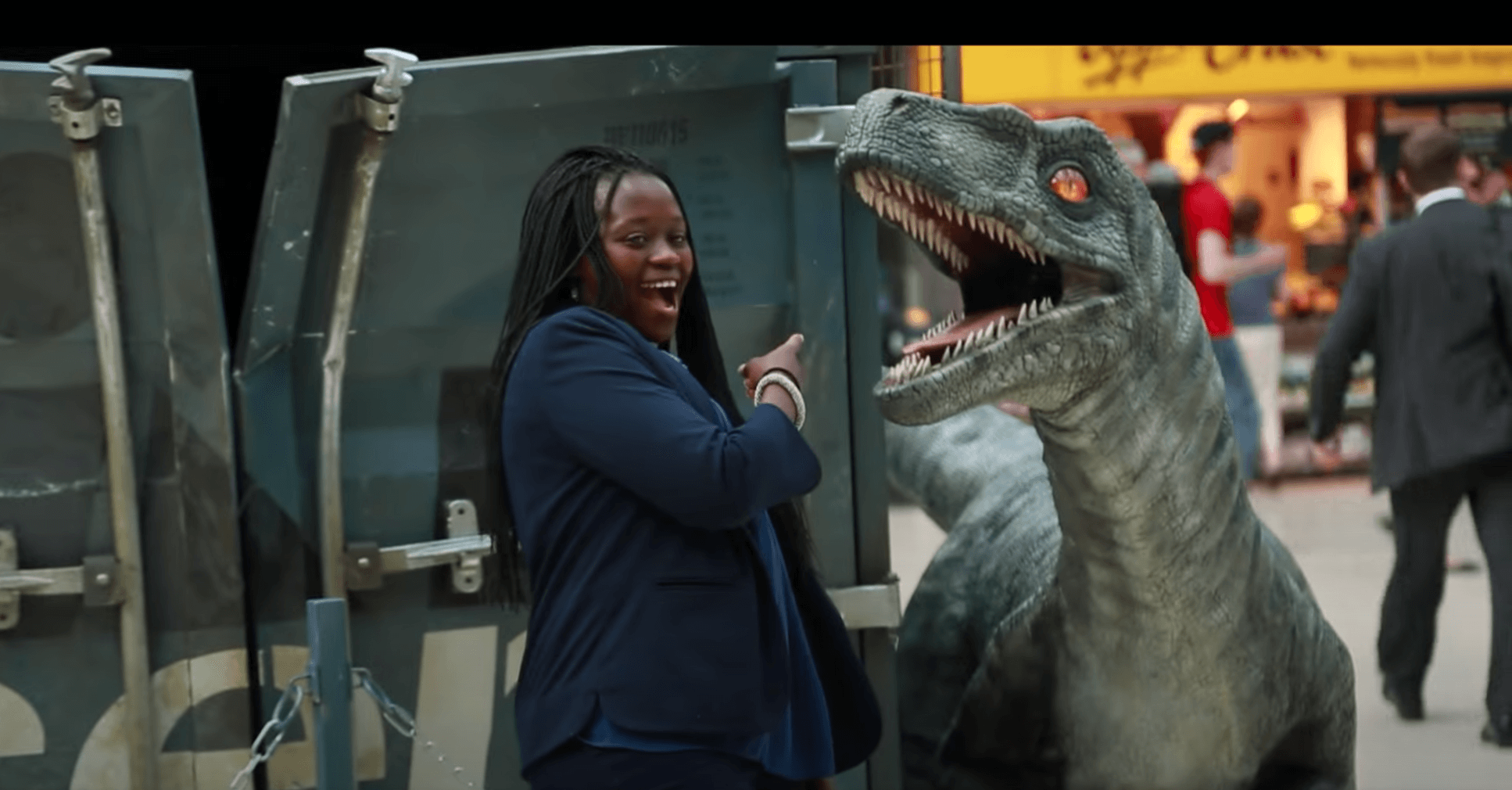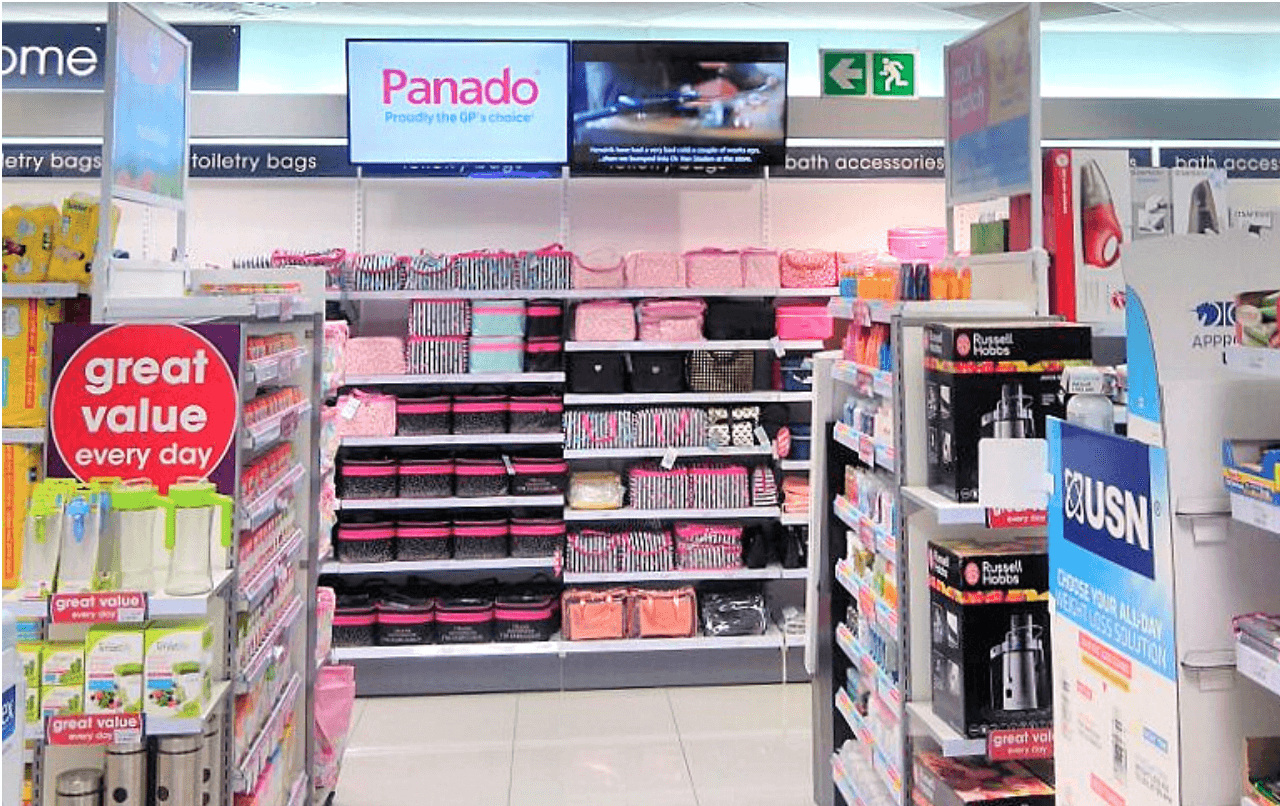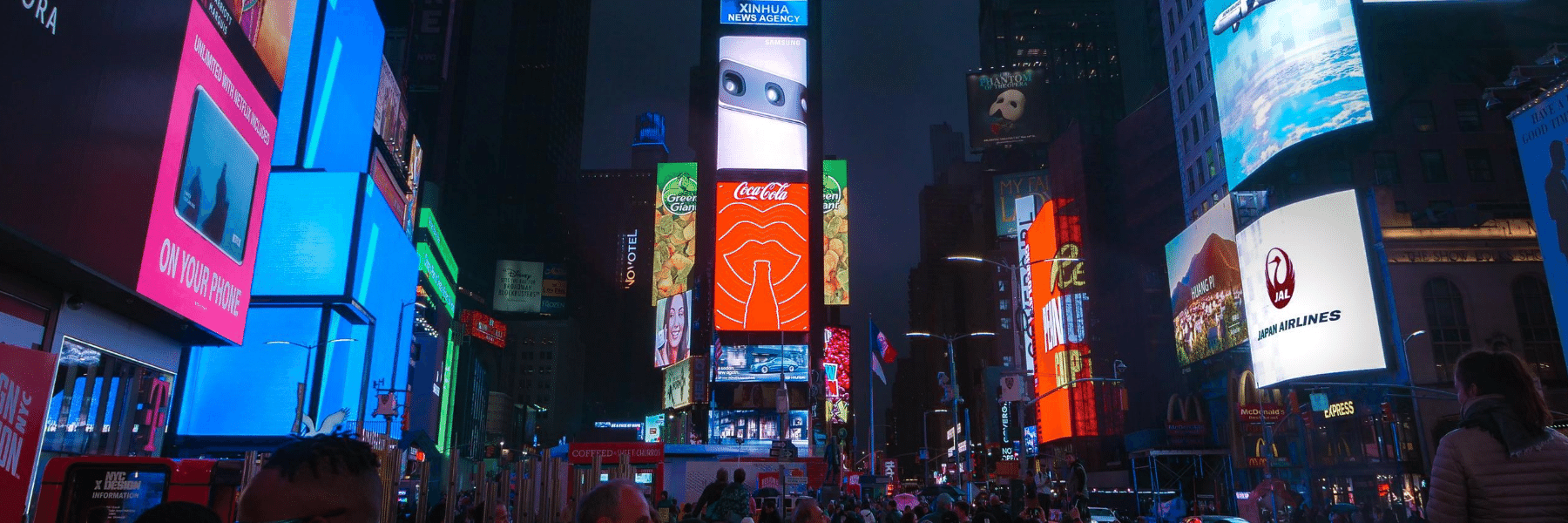The methods by which marketers can reach their target audience continues to rapidly evolve. Thanks to the internet and programmatic capabilities, advertisers have a world of opportunities to create increasingly personal and relevant marketing.
By combining Digital Out-of-Home (DOOH) marketing with programmatic capabilities, programmatic advertisers can reach people online and then retarget them offline, and vice versa. In this way, DOOH is a powerful tool for taking a truly omnichannel approach.
With the global DOOH market projected to reach 8.3 billion by 2023, there’s never been a better time to leverage DOOH for your marketing efforts.
What is DOOH?
DOOH advertising uses digital screens in high-traffic areas to deliver media and content to people. It’s a form of outdoor advertising that can help reach target personas wherever they are.
There are four main types of DOOH formats.
Large Formats are designed and elevated for clear viewing. They’re typically more than 50 feet tall and are placed in high traffic commercial areas, major metropolitan areas, industrial areas and highways. These large format digital billboards create high impact exposure and are available in a wide range of markets.
Spectaculars, like large formats, are high-visibility, high-impact units with full motion. They often target pedestrians in dense foot traffic areas. Spectaculars are often known for their iconic locations, such as Times Square, Sunset Strip, and Piccadilly Circus.
Venue Based and Public Spaces focus on targeting pedestrian traffic. They’re normally placed at street level or within a venue. Common placements include health clubs, train stations, airports, office buildings, taxi cabs, and others. Don’t underestimate these smaller but mighty screens! They allow for more granular targeting and a more intimate viewing experience.
Custom Formats can appear in a variety of large and small DOOH networks. They’re best for creating unique opportunities to reach people such as during events or pop-up installations. Custom format DOOH can take the form of digital projections, digital mobile billboards/buses, or create interactive digital experiences using gesture and touchscreen technologies.
The Advantages of DOOH Over Standard Out-of-Home Advertising & Online Marketing
DOOH has a few key advantages over static forms of out-of-home advertising.
Lower Management Costs: Traditional billboards require printing and installation costs for each new ad. Displaying fresh content on digital billboards can be automated and requires only a few moments to update.
Added Variety: Because digital allows for a variety of content to be displayed, it keeps the content dynamic and interesting for passing pedestrians. With static billboards, the same image might stay for weeks, whereas a DOOH ad can alternate between media every 15 seconds. Being able to change what appears helps keep viewers intrigued and more receptive to messaging.
Increased Opportunities for Campaign Relevancy: When added to programmatic, DOOH can become even more impressive and engaging. By combining creativity and context, marketers can create memorable campaigns that are highly relevant. These types of dynamic ads simply aren’t possible with static displays.
Detailed Reporting: The software used to run DOOH displays produces useful reports that include key metrics such as proof-of-play and incident reports. These analytics enable both marketers and network operators to ensure that ad content is being displayed when it is supposed to and to respond to any issues promptly. In addition, DOOH campaigns can also generate useful viewership analytics.
Fewer Distractions: When running ads on personal devices and web browsers, marketers face frequent obstacles such as ad-blockers, below-the-fold positions, or the user switching between apps or tabs. With DOOH ads, people are more likely to see the digital display if it’s in view.
Marketing Opportunities for DOOH and Programmatic
Although the general advantages of DOOH are persuasive, DOOH becomes even more compelling once you add programmatic advertising capabilities.
Programmatic DOOH Enriches Campaigns with Data
Programmatic DOOH is more personalized, relevant and engaging thanks to data that enriches the campaign. Adding programmatic to DOOH creates a boundless opportunity to use data to trigger content.
A simple example would be delivering different creatives based on time of day. Marketers could also distribute creatives based on advanced data such as weather, market performance, results of a sporting event, and others. With multiple triggers in place, marketers can get specific with who they target and when.
Key data sources for triggering programmatic DOOH are:
- Mobile location data: Mobile data providers have historical and real-time views of audience demographics and movement around their displays. By integrating with DOOH networks, marketers can take advantage of this data for optimizing displays.
- Visual sensors: Certain Ad platforms can let DOOH networks use camera sensors that can detect things like audience demographics, dwell times, engagement, and more.
These data sources can be used in real-time to display appropriate advertising, depending on who’s currently present in the screen’s viewing area. These sources create opportunities for detailed targeting and can track how many people are viewing a DOOH ad at a given time.
Programmatic DOOH Leverages the Open Internet
Marketers that use programmatic aren’t limited by walled gardens such as YouTube, Amazon, Facebook, and Google Ads.
In fact, consumers are most likely to find ads that are relevant to them on the open web. By leveraging the open internet, advertisers can display ads in relevant locations without compromising on transparency or control over when and how the ad is displayed.
Programmatic DOOH is Fast and Flexible
Programmatic data can help refresh DOOH in real-time based on relevant data. With this speed and efficiency, marketers can quickly deliver relevant messaging without making repeated direct buys. Programmatic DOOH ensures that you’re delivering the right message to the right screen at the right time.
Programmatic DOOH Campaigns are Simple to Execute
Integrating DOOH with programmatic efforts creates simplicity in two main ways.
First, programmatic DOOH allows you to buy across multiple publishers simultaneously. It’s easier to build a programmatic campaign that targets screens across a variety of networks than it is to reach out to individual businesses to coordinate your purchase. As more DSPs support programmatic DOOH as a mainstream media buy, it’s becoming increasingly easier to incorporate DOOH media into their campaigns.
Second, you likely already have the creatives you need to start using DOOH. At the end of the day, a DOOH is still a screen. Whether you’re using images, video content, or interactive content, all types of digital creatives can be placed on DOOH displays. Although it may need some tweaking, the bulk of your creative can likely be adapted to DOOH.
Designing an Effective DOOH Marketing Strategy
As with any advertising campaign, DOOH campaigns take some planning and strategy. Here’s our step-by-step guide to designing an effective DOOH marketing strategy.
Choose Key Campaign Objective
DOOH is mainly an impression-based and time-based medium and each DOOH campaign should ideally have one key objective.
When impression-based, the results will be the cost per action (CPA), whereas time-based pricing is largely dependent on impressions and/or share of voice (SOV). Location can also be used to buy inventory in proximity to a specific point of interest, like advertising screens in a subway station, for example.
Although DOOH is great on its own, it can (and should) also support other marketing goals. For example, DOOH is particularly effective at growing online and social media channels, increasing web traffic, promoting online or in-store offers, and supporting retargeting efforts.
Define Target Persona
Once you’ve chosen your key campaign objective, next, choose which target persona to market to and which aspect of the problem you’d like to address.
Here are the four key layers of persona targeting.
- Geo-behavioral Traits: How often the target persona walks by a certain DOOH ad space
- Recency Traits: How recently they walked by
- Loyalty Traits: How much interest they have in the seller’s offering
- Seasonality Traits: How much interest the buyer has based on the season (i.e. summer break, New Years, Halloween, etc.)
In addition, there are three main types of behavioral data (provided through mobile devices).
- Visitation-based behavior: Audiences who have visited a place of interest
- Web-based behavior: Audiences who visited a website or category of websites
- TV viewing behavior: Audiences who viewed a TV show or category of shows
By using mobile device data, these activities can be mapped to a specific audience, which can then inform which DOOH media units to buy. Using this data can help buyers better understand who their ads will reach and allows for highly targeted marketing.
Select Relevant Screens
Once you have established a target persona, you can begin locating DOOH screens which index highly to your audience.
For example, let’s say you are trying to reach high-income adventure travelers. By matching persona data with relevant screens, you might decide to target a specific billboard in an affluent neighborhood, in close proximity to certain sports outfitter stores, or DOOH displays near the airport.
Design Creatives
Now that you have specific goals, target persona, and relevant screens it’s time to choose which creatives to display.
Branded videos are engaging and memorable, but they can also be quite expensive to produce. However, to see the best results with DOOH, branded videos are recommended.
As you design your creative, keep the DOOH format in mind.
Remember to:
- Keep text simple;
- Have a clear call-to-action, and;
- Choose bold visuals that are memorable and easy to understand at a quick glance.
Launch Campaign
At this stage, everything is ready to go. Choose your budget, select your marketing schedule, upload your creatives and launch.
Capture DOOH Campaign Data for Retargeting
Using DOOH campaign data for retargeting is a great way to turn offline impressions into online conversions. Mobile’s GPS, mapping apps, sensors and beacons have allowed mobile retargeting to flourish when used in collaboration with out-of-home advertising campaigns.
By using the mobile data to track who passed your DOOH ads, you can build an audience to retarget online.
Four Programmatic + DOOH Trends
Let’s examine four popular DOOH powered by programmatic trends.
Omnichannel with DOOH
With programmatic DOOH, there’s no need to be restricted to one campaign for mobile, desktop, and OOH. By coordinating efforts across channels, marketing can be delivered both on and offline and become omnipresent.
For example, the marketing team for Jurassic World covered London’s Waterloo Station in advertisements and placed dinosaurs in the middle of the station to create an immersive experience.

They did this in tandem with social, mobile and desktop campaigns to create a truly omnipresent push for their movie. Of course, their budget is out of this world (just like their ad campaign), but it’s a relevant example of an omnichannel DOOH and programmatic approach.
Dynamic Creative and DOOH
Research commissioned by Clear Channel, JCDecaux UK and Posterscope revealed that consumer response was 18% higher when stimulated by relevant content in DOOH campaigns, which leads to a 17% increase in ad recall which in turn delivers a 16% sales uplift.
Despite this compelling research, marketers across the globe often forget to leverage relevance in DOOH campaigns. As programmatic DOOH gains speed, we can expect to see creativity and relevancy when it comes to designing engaging displays.
In-store Digital Signage
In-store DOOH is often overlooked since advertisers focus on getting people in the door. However, in-store DOOH can help close the ‘last mile’ between browsing in-store and the purchase counter.
Clicks, a health and beauty retail chain in South Africa, used digital signage to inform customers as they walked through their stores.

They displayed promotions, campaigns and supplier advertising to capture the attention of whoever was walking by. The digital signage helped to boost dwell times (the time a person looks at the ad) and sales.
In-store digital signage is a great way of notifying potential customers of sales and discounts and directing traffic to secure that final sale. By combining in-store digital signage with beacons and geofencing, brick and mortar stores can generate powerful results.
Improved Analytics
In the past, marketers avoided DOOH due to its limited measurable results. But with programmatic, it’s now possible to measure who consumed the content, when, and even for how long.
Programmatic DOOH makes it easy to collect data that helps target the right audience and display relevant ads to your target persona.
Three Examples of Memorable DOOH Campaigns
DOOH technology can create opportunities for a targeted and engaging display experience. Here are three examples of marketers who created memorable DOOH campaigns.
GMC’s Highly Interactive DOOH Campaign
In this GMC campaign, they aimed to promote their newest vehicle, the Acadia SUV. GMC’s DOOH used facial analytics technology, dynamic content, proximity-based marketing, and digital signage to attract and engage their audience.
A strategically placed camera was used to anonymously detect audience demographics (e.g., age and gender) and behavior. The campaign then used artificial intelligence to display one of over 30 prepackaged videos to the audience.
The result was a memorable display that had people laughing, smiling, and excited to engage with the campaign.
Spotify’s Wrapped Celebrating Playlists
Spotify’s DOOH campaign was based on user-generated data, making it dynamic, clever and relatable. Through their user-generated data, they created a localized story to each country and delivered it to DOOH screens around the world.
It got people interested in their own personal playlists and likely sparked people to visit the app and review their own music listening statistics.
Douwe Egberts Coffee: One Yawn Earns One Coffee
Douwe Egberts designed a clever DOOH campaign for their coffee. They recognized that airports are one of the prime places people crave a caffeinated boost. But given how ad-heavy airports can be, they knew they had to create a memorable campaign that could cut through the noise.
Their solution was to develop a facial analytics campaign that created a fresh cup of coffee if a tired traveler yawned in front of the display.
As shown in the video, not only did consumers appreciate the cozy cup of coffee, but they were also entertained and intrigued by the kiosk and many left the display with a smile.
Conclusion
Programmatic DOOH helps scale the benefits of traditional OOH and non-programmatic DOOH even further. By enriching campaigns with target persona data, programmatic DOOH allows marketers to create engaging, immersive, and memorable campaigns that resonate.
Pairing DOOH with programmatic abilities is key to staying ahead of the curve and seeing even more ROI from DOOH campaigns.
If you have questions on how DOOH can help your agency clients, our strategists are available for free strategic consultations. We’d be happy to support you in creating a breakthrough programmatic DOOH campaign.
Images:
Header image: Aleksas Stan on Unsplash
Image 1: YouTube
Image 2: Digital Signage Today
Video 1: YouTube
Video 2: Vimeo
Video 3: YouTube
